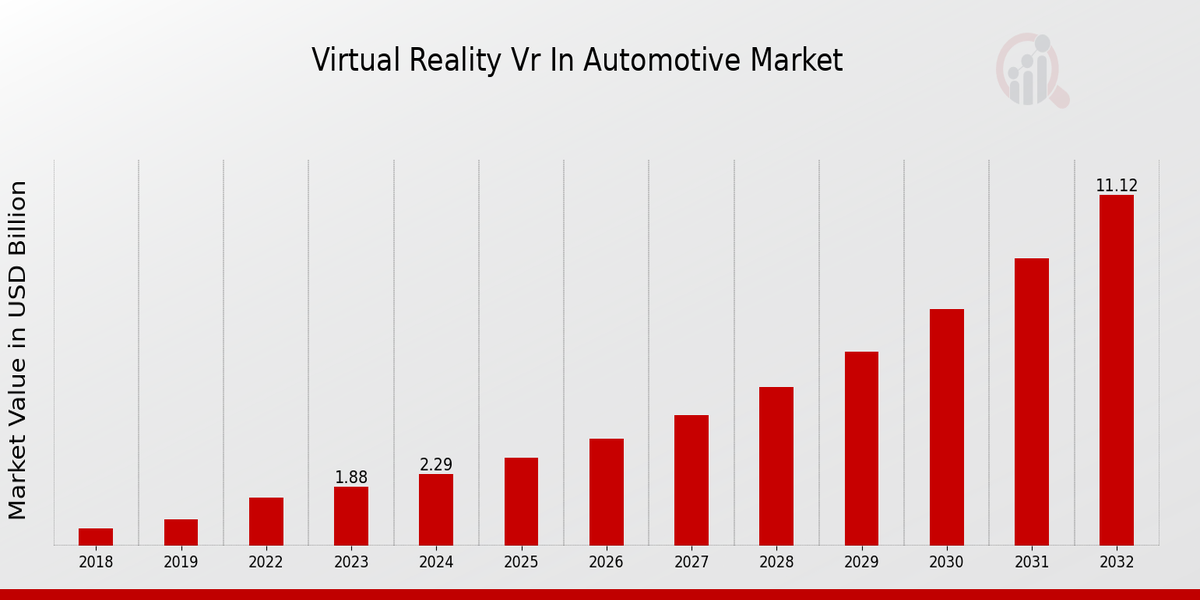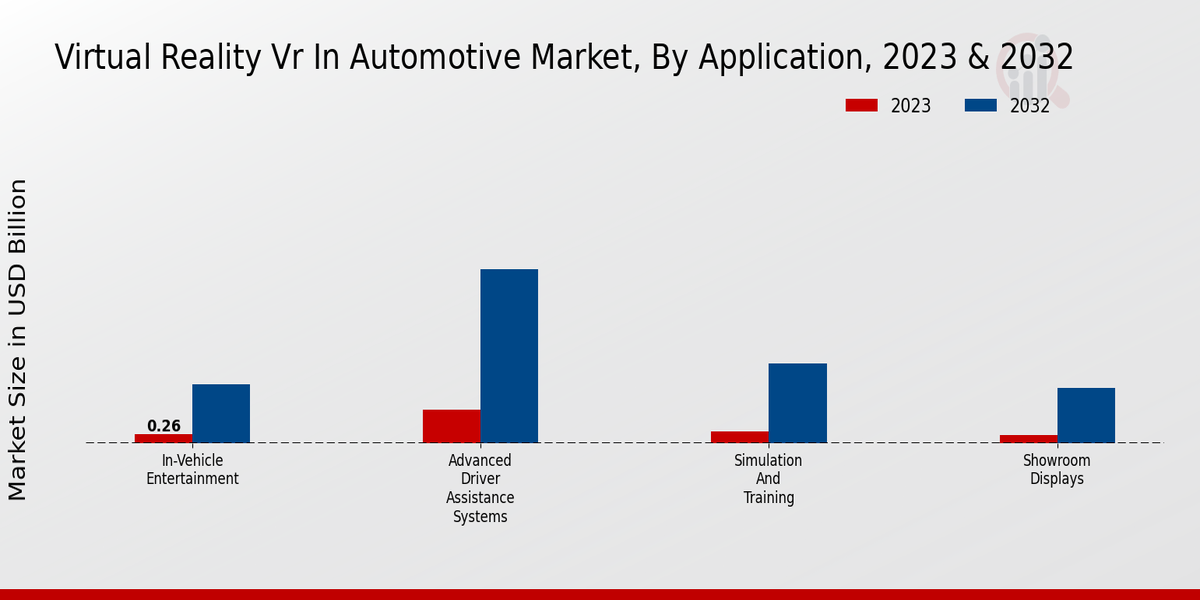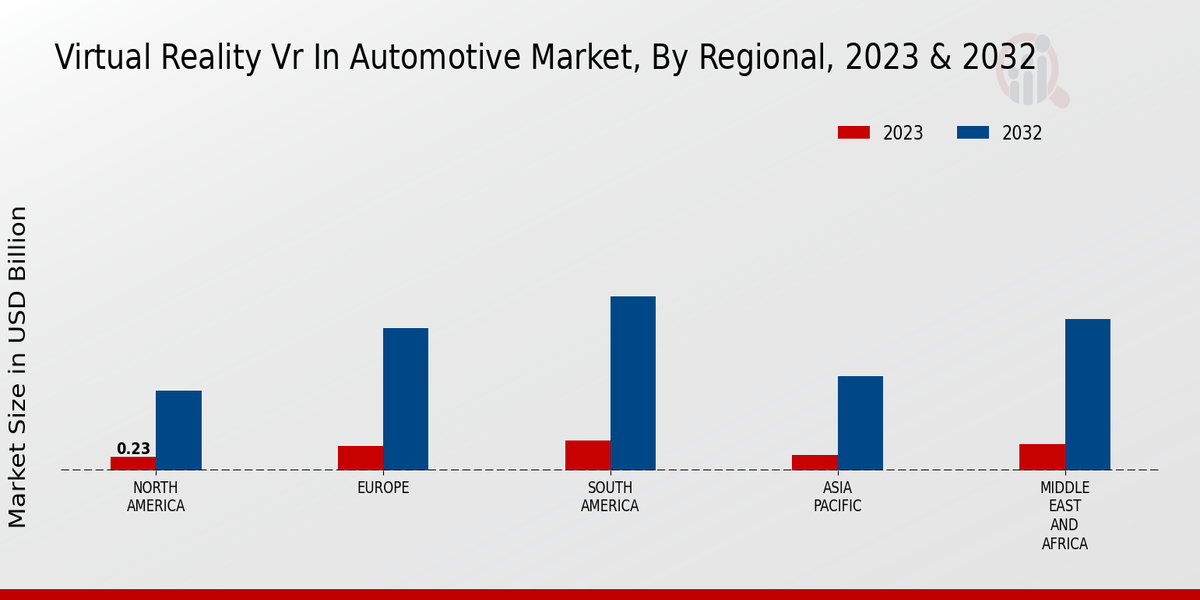Virtual Reality In Automotive Market Overview
As per MRFR analysis, the Virtual Reality In Automotive Market Size was estimated at 1.54 (USD Billion) in 2022. The Virtual Reality In Automotive Market Industry is expected to grow from 1.88(USD Billion) in 2023 to 11.12 (USD Billion) by 2032. The Virtual Reality In Automotive Market CAGR (growth rate) is expected to be around 21.87% during the forecast period (2024 - 2032).
Key Virtual Reality In Automotive Market Trends Highlighted
The growing market for virtual reality (VR) in automobiles worldwide is boosted by technological advancements and the rising need for immersion. Key drivers include the desire to improve in-car entertainment, use virtual simulations to ensure safety and streamline automotive design/production methods.
Some opportunities for exploring VR extend beyond leisure activities into areas such as remote vehicle viewing through virtual showrooms and advanced training of technicians using simulation models. There are chances of hybrid experiences that can enhance the overall driving experience if VR gets integrated with other technologies like augmented reality (AR).
Recent developments witnessed in the VR in Automotive market include increased resolution and lower latency VR headsets, specialized VR platforms designed for the automotive industry, and partnerships between auto manufacturers and VR technology providers that have resulted in cutting-edge solutions. These advancements are expected to drive further adoption and innovation in the years to come.
Fig 1: Virtual Reality In Automotive Market Overview

Source: Primary Research, Secondary Research, MRFR Database and Analyst Review
Virtual Reality In Automotive Market Drivers
Increasing Adoption of Advanced Technologies in the Automotive Industry
In the automobile sector, the adoption of artificial intelligence (AI), machine learning (ML), and the Internet of Things (IoT) as cutting-edge technologies are leading to a rapid transformation. Through these technologies, car manufacturers are developing innovative approaches to improve vehicle safety, efficiency, and comfort. In the automotive industry, virtual reality (VR) represents one of the most promising technologies that can create immersive experiences that simulate real-life situations for drivers and passengers.
Moreover, VR may simulate a number of driving situations so that drivers can perfect their skills in an environment that is safe and controlled. It also offers opportunities for entertainment to passengers through interactive games, movies and educational content. The increase in demand for virtual reality solutions is anticipated with the increased introduction of advanced technology in the automotive sector itself.
Growing Demand for Immersive and Personalized In-Vehicle Experiences
Consumers are increasingly demanding more immersive and personalized experiences in their vehicles. VR can provide these experiences by creating virtual environments that can be tailored to the individual preferences of each driver and passenger. For example, VR can be used to create custom dashboards, infotainment systems, and even entire virtual worlds that can be explored. As the demand for immersive and personalized in-vehicle experiences continues to grow, the market for VR solutions is expected to expand rapidly.
Government Regulations and Initiatives Supporting the Adoption of VR in Automotive
Governments around the world are increasingly recognizing the potential of VR to improve the safety and efficiency of the transportation sector. As a result, many governments are implementing regulations and initiatives to support the adoption of VR in automotive applications. For example, the US government has invested in the development of VR-based driver training programs, and the European Union has launched a number of initiatives to promote the use of VR in the automotive industry.As government support for VR continues to grow, the market for VR solutions is expected to benefit significantly.
Virtual Reality In Automotive Market Segment Insights
Virtual Reality In Automotive Market Application Insights
Virtual Reality (VR) in the automotive industry is gaining traction due to its potential to enhance the driving experience, improve safety, and streamline training processes. There are four main segments in the application section of the global market for Virtual Reality in Automotive. They include In-Vehicle Entertainment, Advanced Driver Assistance Systems (ADAS), Simulation and Training, and Showroom Displays. VR is one of the most promising applications for entertainment in automobiles. For passengers, VR headsets can offer immersive entertainment experiences such as watching movies, playing games or even roaming virtual worlds while on a journey.
VR technology is expected to develop significantly, with an estimated USD 1.5 billion worth of in-vehicle entertainment market by 2024 at a CAGR of 25.4% from 2024-2032. The key players involved here are major auto manufacturers like Audi, BMW and Mercedes-Benz, among others, alongside VR technology providers such as HTC Vive and Oculus. ADVANCED DRIVER ASSISTANCE SYSTEMS (ADAS) makes use of VR to create practical driving simulations where drivers can practice their skills in a controlled environment so as to get better at it over time. This innovation will be vital when it comes to reducing road accidents as well as ensuring overall safe driving.
The global VR–based ADAS market is expected to touch USD 1.2 billion by 2024, increasing at a CAGR of 22.6% from 2023 to 2032. This includes companies offering automotive technologies, such as Continental, Delphi and Bosch. Another main use of VR in the auto industry is simulation and training. Cheap and immersive virtual reality training simulators are available for drivers, technicians, among other vehicle professionals. In this manner, trainees can practice complex procedures and scenarios in a controlled but realistic environment, thus reducing accident risk and improving the general outcomes of training.
The worldwide VR-based simulation and training market for the automotive sector is estimated to reach $0.9 billion by 2024, registering a CAGR of 20.4% over the period of projection (from 2024 to 2032). Amongst these are VR simulation technology providers like VirTra as well as Simi Reality Motion Systems, who provide the key players within this field. Showroom Displays now also use more VR to offer customers immersive interactive experiences with their products. The use of VR headsets allows customers to virtually explore vehicles, customize their configurations or even take virtual test drives with them. It improves customer experience, which leads to increased sales conversions
It is anticipated that the automotive sector’s global virtual reality (VR) based display system market will hit around $0.7 billion by 2024, with a CAGR of 18.7% from 2024 to 2032. The major players in this field are car makers and providers of VR technology.
Fig 2: Virtual Reality In Automotive Market Insights

Source: Primary Research, Secondary Research, MRFR Database and Analyst Review
Virtual Reality In Automotive Market Technology Insights
The technology segment is broadly classified into Head-Mounted Displays (HMDs), Head-Up Displays (HUDs), Gesture Recognition, and Haptic Feedback. Among these, HMDs account for the largest revenue share in the Virtual Reality In Automotive Market and are expected to maintain their dominance throughout the forecast period. The growth of this segment can be attributed to the increasing adoption of HMDs in various automotive applications, such as infotainment, navigation, and driver assistance systems. HUDs are also gaining popularity in the automotive industry, as they provide drivers with important information without having to take their eyes off the road.Gesture recognition and haptic feedback technologies are still in their early stages of development, but they have the potential to revolutionize the way drivers interact with their vehicles.
Virtual Reality In Automotive Market Vehicle Type Insights
The Vehicle Type segment in the global Virtual Reality (VR) Automotive Market is anticipated to witness substantial growth in the coming years. This segment comprises passenger cars, commercial vehicles, trucks, and buses. Passenger cars are projected to hold a significant share of the market due to the increasing adoption of VR technology for enhanced driving experiences and safety features. Commercial vehicles are also expected to contribute significantly to the segment's growth, driven by the demand for VR-based training and simulation solutions for drivers. Trucks and buses are expected to witness steady growth as VR technology is leveraged for fleet management and passenger entertainment. The Virtual Reality In Automotive Market revenue for Vehicle Type segment is projected to reach USD 3.28 billion by 2024, exhibiting a CAGR of 24.5% during the forecast period 2024-2032.
Virtual Reality In Automotive Market Usage Insights
Standalone and integrated with existing systems are the two categories used to segment the market based on usage. In 2023, the standalone segment held the larger market share and is anticipated to maintain its dominance throughout the forecast period. This is due to the rising popularity of standalone VR headsets, which do not need a connection to a PC or console. Integrated systems are becoming more popular since they provide a more immersive and realistic VR experience. The Virtual Reality In Automotive Market was valued at USD 1.88 billion in 2023, and it is expected to reach USD 11.12 billion by 2032, exhibiting a CAGR of 21.87% during the forecast period. This market segmentation data and insights are critical for businesses to understand the market dynamics and make informed decisions.
Virtual Reality In Automotive Market End User Insights
The Global Virtual Reality (VR) in Automotive Market segmentation by End User includes Automakers, Tier 1 Suppliers, and Third-Party Companies. Automakers are expected to hold the largest share of the market in 2023, owing to their increasing investments in VR technology for product development, design, and training. Tier 1 Suppliers are also expected to contribute significantly to the market growth, as they provide VR solutions and services to automakers. Third-party companies are expected to play a crucial role in the market by offering innovative VR solutions and services to both automakers and Tier 1 Suppliers.
Virtual Reality In Automotive Market Regional Insights
The Virtual Reality In Automotive Market is segmented into North America, Europe, APAC, South America, and MEA. Among these regions, North America held the largest market share in 2023 and is expected to continue its dominance throughout the forecast period. The growth in this region is attributed to the presence of major automotive manufacturers and the early adoption of advanced technologies. Europe is another significant region in the Virtual Reality In Automotive Market, owing to the presence of several automotive companies and government initiatives promoting the adoption of virtual reality in the automotive industry.APAC is also expected to witness significant growth in the coming years, driven by the increasing demand for automobiles and the growing adoption of virtual reality technology in the region. South America and MEA are expected to register a steady growth rate during the forecast period.
Fig 3: Virtual Reality In Automotive Market Regional Insights

Source: Primary Research, Secondary Research, MRFR Database and Analyst Review
Virtual Reality In Automotive Market Key Players And Competitive Insights
The Virtual Reality (VR) in Automotive Market is highly competitive, with several major players vying for market share. Some of the leading players in the industry include NVIDIA, Qualcomm, Samsung Electronics, Sony Interactive Entertainment, and Vuzix Corporation. These companies offer a wide range of VR solutions, including hardware, software, and services, to meet the diverse needs of automotive manufacturers. The competitive landscape is characterized by continuous innovation and technological advancements as players strive to differentiate their offerings and gain a competitive edge.
A prominent competitor in the VR Automotive Market is NVIDIA. With its expertise in graphics processing units (GPUs), NVIDIA provides high-performance VR solutions that enable automakers to create immersive and realistic driving experiences. The company's DRIVE VR platform is designed specifically for automotive applications, offering advanced features such as real-time rendering, physics simulation, and artificial intelligence. NVIDIA has partnered with leading automakers, including Audi, BMW, and Mercedes-Benz, to integrate its VR technology into their vehicles.
Another key competitor in the market is Qualcomm. The company's Snapdragon VR platforms are widely used in smartphones, tablets, and VR headsets. Qualcomm's VR solutions are known for their low power consumption and high performance, making them suitable for integration into automotive systems. The company has collaborated with automakers such as Ford and General Motors to develop and deploy VR-powered features in their vehicles, including virtual showrooms and interactive driver assistance systems.
Key Companies in the Virtual Reality In Automotive Market Include
- HTC
- Meta
- DPVR
- Google
- Microsoft
- Vuzix
- Sony
- Skyworth
- Apple
- OnePlus
- Nreal
- Shadow Creator
- Pico Interactive
- Goertek
- Samsung
Virtual Reality In Automotive Market Industry Developments
The Global Virtual Reality (VR) in Automotive Market is projected to reach USD 11.12 billion by 2032, exhibiting a CAGR of 21.87% during the forecast period (2024-2032). Recent advancements in VR technology and its increasing adoption by automotive manufacturers are driving market growth. VR is used for various applications in the automotive industry, including product design, simulations, driver training, and marketing.
Notable developments in the market include the launch of new VR headsets with improved resolution, field of view, and tracking capabilities. Automotive companies are also partnering with VR technology providers to develop customized solutions tailored to their specific needs. For instance, in 2023, Volkswagen announced a partnership with HTC Vive to create a VR-based training program for its employees. Key market players include Meta Platforms, Inc., HTC Corporation, Sony Interactive Entertainment, and Google LLC. These companies are investing heavily in research and development to enhance their VR offerings and expand their market presence.
Virtual Reality In Automotive Market Segmentation Insights
Virtual Reality In Automotive Market Application Outlook
- In-Vehicle Entertainment
- Advanced Driver Assistance Systems (ADAS)
- Simulation and Training
- Showroom Displays
Virtual Reality In Automotive Market Technology Outlook
- Head-Mounted Displays (HMDs)
- Head-Up Displays (HUDs)
- Gesture Recognition
- Haptic Feedback
Virtual Reality In Automotive Market Vehicle Type Outlook
- Passenger Cars
- Commercial Vehicles
- Trucks and Buses
Virtual Reality In Automotive Market Usage Outlook
- Standalone
- Integrated with Existing Systems
Virtual Reality In Automotive Market End User Outlook
- Automakers
- Tier 1 Suppliers
- Third-Party Companies
Virtual Reality In Automotive Market Regional Outlook
- North America
- Europe
- South America
- Asia Pacific
- Middle East and Africa
| Report Attribute/Metric |
Details |
| Market Size 2022 |
1.54(USD Billion) |
| Market Size 2023 |
1.88(USD Billion) |
| Market Size 2032 |
11.12(USD Billion) |
| Compound Annual Growth Rate (CAGR) |
21.87% (2024 - 2032) |
| Report Coverage |
Revenue Forecast, Competitive Landscape, Growth Factors, and Trends |
| Base Year |
2023 |
| Market Forecast Period |
2024 - 2032 |
| Historical Data |
2019 - 2023 |
| Market Forecast Units |
USD Billion |
| Key Companies Profiled |
HTC, Meta, DPVR, Google, Microsoft, Vuzix, Sony, Skyworth, Apple, OnePlus, Nreal, Shadow Creator, Pico Interactive, Goertek, Samsung |
| Segments Covered |
Application, Technology, Vehicle Type, Usage, End User, Regional |
| Key Market Opportunities |
Immersive Virtual Showrooms Enhanced Vehicle Testing Remote Diagnostics and Maintenance Personalized InVehicle Experiences Driver Safety Training |
| Key Market Dynamics |
Increasing demand for immersive experiences Growing adoption of VR for virtual showrooms Advancements in VR technology Government regulations for autonomous driving Partnerships and collaborations between automakers and VR providers |
| Countries Covered |
North America, Europe, APAC, South America, MEA |
Frequently Asked Questions (FAQ) :
The global Virtual Reality (VR) in the Automotive market was valued at USD 1.88 billion in 2023 and is projected to reach USD 11.12 billion by 2032, exhibiting a CAGR of 21.87% during the forecast period.
North America is expected to dominate the VR in Automotive market throughout the forecast period. In 2023, the region accounted for a 35.2% share of the global market and is projected to maintain its dominance due to the presence of major automotive manufacturers and early adoption of advanced technologies, including VR.
VR finds applications in various aspects of the automotive industry, including vehicle design and engineering, manufacturing, marketing and sales, and customer service. VR enables designers to visualize and simulate vehicle components and systems, enhancing the design process. It is also used for training and simulation purposes, providing immersive experiences for drivers and technicians.
Leading players in the VR in the Automotive market include NVIDIA, Qualcomm Technologies, Visteon Corporation, Robert Bosch, Continental AG, Panasonic Corporation, DENSO Corporation, Samsung Electronics, and Sony Interactive Entertainment. These companies offer a range of VR solutions and technologies, including hardware, software, and content.
Factors driving the growth of the VR in Automotive market include increasing demand for immersive and interactive experiences, advancements in VR technology, growing adoption of autonomous vehicles, and government initiatives promoting the adoption of VR in the automotive industry.
Challenges faced by the VR in Automotive market include the high cost and complexity of VR systems, limited availability of VR-compatible content, motion sickness and discomfort associated with VR use, and privacy and security concerns related to VR data collection.
Emerging trends in the VR Automotive market include the integration of VR with other technologies such as artificial intelligence (AI), 5G, and cloud computing, the development of lightweight and portable VR headsets, and the increasing use of VR for remote collaboration and training.
The global VR in Automotive market is projected to reach USD 4.24 billion by 2032, exhibiting a CAGR of 19.2% from 2024 to 2032.
The vehicle design and engineering segment is expected to hold the largest market share during the forecast period. VR provides immersive and interactive experiences for designers and engineers, enabling them to visualize and simulate vehicle components and systems, enhancing the design process.
The VR in Automotive market in the Asia-Pacific region is projected to grow at a CAGR of 23.5% from 2024 to 2032, driven by increasing demand for VR-based solutions in the automotive industry, particularly in countries like China, Japan, and South Korea.

















